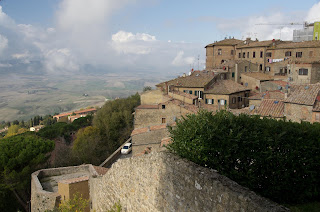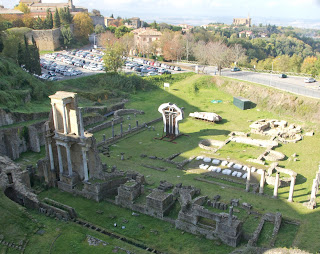Volterra is another of the many interesting Tuscan hill
towns. After spending one afternoon walking the streets, I do want to return
one day and spend more time. While we saw much of what it has to offer and
purchased some lovely alabaster jewelry for Linda, there is much that we did
not see in this small town.
 |
| Town hall |
 |
| Coats of arms of past mayors, a common practice in Italy |
Volterra is best known for its Etruscan remains (not the
Twilight vampire series). The Etruscan empire included most of what is today
Tuscany from just north of Rome to the Apennine mountains and the sea. Flourishing
in Italy during the time of Greek greatness, its culture included much of what
would become Roman culture and the foundations of Western ideals. Ultimately,
the Etruscans would be conquered by Rome beginning in 509 BE. Etruscan history
lives on in Volterra with the only remaining Etruscan city gate in all of the
region and an archaeological park with ongoing excavations on the hill
overlooking the town. We only had a quick glimpse of the park in the twilight
before we had to leave for home in Orvieto, one of the reasons I would like to
return and spend more time in the town.
 |
| Remains of the Acropolis |
 |
| The high-security prison |
The archaeological park remains because the Florentines
destroyed the buildings and used the area as a way to protect themselves from
the townspeople when they took over the town in 1472. The fort that they built
to protect their army is today a maximum security prison housing 150 special
prisoners. Many would be from Sicily as the authorities like to separate the
criminals from their family ties. The Florentine work has left Volterra with a
beautiful park atop its highest hill and a marvelous archaeological site where
we continue to learn about the Etruscans.
Another of the interesting sights in Volterra is the Roman
theater. Forgotten until the 1950s, this theater was rediscovered by an amateur
historian who proceeded to excavate it with the help of mental patients at the
local hospital. According to the guide book, this work proved to be therapeutic
although there is no mention of how many were actually cured by the work. At
any rate, the results of their work are interesting as we can now see the
outlines of the theater while walking around the edge of the town along its
remaining wall. One portion of the backdrop has been rebuilt so visitors can
see the different levels of the stage, one for mortals, the second for heroes,
and the third for the gods. In the third century AD, the locals began tearing
down the theater and using the stones for bath behind the theater. I guess they
found more entertainment in the warm water than on the stage.
 |
| Note the small door and the few inches of space between the buildings |
We had rented one of those audio tour guides which helped
quite a bit with learning about the town. The most interesting discovery it
shared were the tower houses of Buonparenti and Buonaguidi. They had filled in
the space between the two towers with a house once they had quit fighting each
other. One narrow dooway was all that led up to the living spaces above the
shops on the street. Behind the door was a ladder they pulled up at night for
extra security. This arrangement meant that one man could easily defend both
homes from any attackers.
 |
| Wooden sculpture of the Deposition |
We also visited the Duomo built in the 12th
century and the baptistery facing the entrance to the cathedral in Pisan style.
One interesting feature is the sculpted relief of the last supper with Judas
under the table being attacked by a dragon. Another shows the scene when God
asked Abraham to prove his love by sacrificing his son Isaac. Mary is shown
with daggers symbolizing the pain she felt as Jesus was crucified.
 |
| Walls braced with arches, another common feature in these old towns. |
 |
| A sculpture on a wall of a random building |
Volterra is also justly famous for its alabaster. The nearby
quarries provide the raw material for the many artists who work with the stone.
The museum, which we will visit on another trip, has examples that go back to
Etruscan times. Several different shops sell the wares and it is possible to
visit workrooms where the artists are creating their finery. Alabaster’s
transluscent character makes it a very special stone. Carved thinly it makes
for stunning and lovely light fixtures. If we still had a house we might have
bought one or two, but the condo is just too small for such finery.




















No comments:
Post a Comment